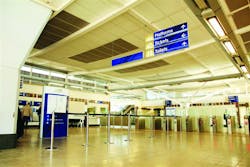Informational Display
Airports have a high-density footfall that is concentrated through a series of bottlenecks against a background of constant time pressure and security checks, creating what could be one of the most stressful experiences enjoyed on a routine daily basis.
A study carried out in 2007 by Dr. David Lewis showed that stress levels of passengers navigating through an international airport could exceed those of sky-divers and F1-race drivers. Increased stress levels can cause serious health risks, and furthermore, stressed, hurried, and lost passengers will be far less inclined to spend time in airport shops.
The challenge for airport operators is to enable passengers to find their way through various check-in systems, through security, and to their gate as easily and stress-free as possible.
As airports have expanded to accommodate the growth of mass transportation, effective signage has become paramount in their efficient operation.
Modular technology
Good wayfinding signage inspires trust in passengers, making them feel at ease and in control of their situation and confidant that they will make it to their required destination without trouble.
It isn’t just wayfinding signage that needs to be adequate, each airline carrier also uses signage to assert their presence, competing with other carriers in a bid to direct its customers and attract attention to its brand.
Signs need to be conspicuous, contrasting to their surrounding environment, and must help users complete their task. They must also be consistent in style and message, and be clear and easily recognizable.
For both airports and carriers, there is a strong need for rugged yet simple and flexible signs, which is where Modular Curved Frame Technology (MCFT) sign systems come in. MCFT sign systems fill the gap between modular sign systems and custom-designed sign solutions, as they offer a wide selection of modular sign solutions which can be customized to meet specific requirements.
A well-designed MCFT sign system will offer an airport a complete solution for the entire facility. Above all, the MCFT sign system enables users to change the graphics easily and cost effectively, which is always important in an environment as fluid as an airport.
An effective MCFT sign system also allows users to maintain strong consistency in look and feel. It is interesting to note that Heathrow recently asked its [airlines] in the newly refurbished T4 to use only signage that conformed to a very tight specification. The guidelines were produced by the Heathrow Airport Authority (HAL) so that there would no longer be a plethora of banners, totems, mini totems, etc. all competing and producing a very confused image at the check-in concourse.
The specification that HAL/BAA issued was almost identical to the new totems that had been developed for British Airways in their new T5: elegant, strong units, easy to move, and secure from most passenger abuse.
The trend of airports dictating what can and cannot be used will almost certainly continue as airports strive to continually improve passenger experience.
Choosing a system
It would be wise to invest some time and research when choosing a favored system, as switching systems too often can prove to be a waste of time and money spent on training, planning, and correction of errors.
Samples - The first step is to ask for free samples. A sign fabricator that will not offer free samples indicates that their marketing strategy and overall level of awareness to service are low, and should be avoided.
Design - Although there are exceptions, in most cases, whether the system is flat concave, or convex-shaped, it is important that it has a modern, contemporary, and clean look.
Quality of materials - It is not always easy to assess the quality of materials used by the manufacturer. Request data sheets that reflect the specifications of the system, its ability to withstand the elements, and its compatibility with indoor/outdoor use. Check the stability of the components before and after assembly.
Simplicity - Try to choose a system that is simple to use, assemble, and install.
Wide range of sizes - Using a modular system naturally limits the design options to the number of sizes offered by a particular system. Choose a system with a wide range of sizes. This will reduce the chance of your system being rejected by the customer or designer. It is advantageous to use a single product line per project. Look for a comprehensive system that can cover signs from the parking lot to the boarding gates.
Braille compatibility - There are a number of technologies available today to create compliant, Braille signage, each with its own special features and price. It is imperative that the system you use is compatible with as many Braille/ADA/DDA signage methods as possible, in order to maintain both cost effectiveness and versatility when competing on projects.
Service and support - Pay special attention to the level of service you are receiving in the early stages. Talk to colleagues to get their opinions and impressions and ask about their experience with the products. Check to see what fabrication services are offered by the vendor. Sometimes, it will prove cost effective to have some of the fabrication done by the vendor. Also, check the delivery times; it is important to work with a vendor you can count on to deliver as quoted.
Price - The best system does not necessarily have to be the most expensive one. Shop around and remember to compare the amount of work involved in the fabrication, which can ultimately translate into expensive labor dollars.
